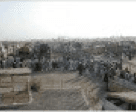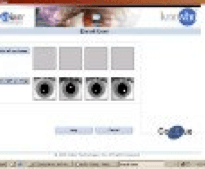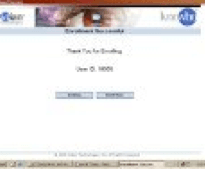The Customer Requirement
Between March and August 2002 more than 1 million Afghan refugees returned home from Pakistan where that had found temporary shelter from years of war in their country. UNHCR facilitated this repatriation by its voluntary repatriation programme. Once in Afghanistan, returnee families transit through UNHCR encashement centers to receive cash grants . Each family also receives food and non-food items.


Afghan Refugees waiting their turn to be registered at the UNHCR registration center in Peshawar
The proximity of the return areas in Afghanistan makes it easy for returnees to come back to Pakistan and pose for Voluntary Repatriation a second or third time (recycling). There are also genuine refugees with no intention to remain in Afghanistan, many renting themselves out to well-organized traffickers. Furthermore, Pakistanis who belong to the same tribe as the returnees (Shinwari) may pose as refugees to benefit from the cash grant. Traditional verification methods that help to differentiate genuine refugee-returnees from recyclers and false refugees include verification by photo-ID, interviews and luggage checks but with very high numbers of individuals these methods start to prove ineffective.
The Solution
The solution developed for the UNHCR is based on biometric registration (Iris Recognition enrollment) of all refugees claiming repatriation assistance from UNHCR when repatriating from Pakistan to Afghanistan so that any multiple claimants can be identified. During enrollment the entire database is checked whether an individual was registered before. Only the biometric information is presented to the database (1 to many search) without any further personal / demographic information. This process only takes a couple of seconds. If the individual has been registered before, the application will report a “recycler” incident.
UNHCR Project 2002: The Pilot
The test phase of the Iris Recognition Refugee Enrollment System was implemented at the UNHCR Voluntary Repatriation Center in Takhta Baig, NWFP, Pakistan, in September 2002. BioID developed the application, deployed the hardware and software and outsourced the daily management of the installation and enrollment operation with local staff.
The objective was to enroll all adult refugees. In the interest of maintaining privacy, and to comply with the UNHCR refugee protection mandate, no other information (demographics) about the refugee is stored in the database. The Iris Recognition server will not permit a person to be enrolled more than once. In the case that an individual appears a subsequent time the person is identified as a duplicate enrollee and rejected. In three weeks time some 15,000 individuals were registered and recyclers successfully detected. The number of recycler attempts was reduced drastically once the refugee population understood the effectiveness of the new registration method. BioID passed all UNHCR technical and implementation assessment criteria with excellence and was awarded subsequently the 2003 and 2004 contracts for the entire repatriation exercise as regards biometric registration.
UNHCR Project 2003-2006: Full Deployment
The 2003 and 2004 operations represent a rollout of the biometric registration capacity to accommodate all refugees of 6 years of age and older that return to Afghanistan. 200,000 refugees were registered in 2003 while a further 300,000 individuals were registered in 2004 and 2005. Total to date in 2006: 1,000,000. The Iris Registration centers deployed and managed by BioID Technologies are:
- Hyatabad, Peshaware Pakistan
- Ali Zai, Khurram Agency, Pakistan
- Chaman, Baluchistan, Pakistan
- Baleli, Quetta, Baluchistan, Pakistan
- Khost, Afghanistan
.png&w=640&q=75)
In addition BioID Technologies have designed a mobile Iris Registration unit and deployed three such systems for registration in remote areas in Pakistan and Afghanistan.
The role of Anonymous Biometric Enrollment is now extended to ascertain that refugees applying for a UNHCR grant in one of the designated Iris Recognition registration centers have not applied for such a grant at any of the other centers before (recyclers). As such, the Iris Recognition test is an integral part of the overall UNHCR procedure of verifying genuine refugee status.
Enrollment and Identification Procedure
.png&w=640&q=75)
The Iris test is performed as part of the UNHCR procedures to verify true refugee status of the applicants that visit one of the UNHCR Iris test centers. All centers have a network of Iris Recognition cameras (ranging from 2 - 9 depending on the required capacity). The individual is asked to sit down in front of one the cameras and is briefed by the operator. A series of enrollment images are taken and sent to the server in the network. This system converts the appropriate image into an Iriscode (a digital representation of the information that the iris pattern constitutes) and checks the entire database whether that IrisCode matches with one already stored. If that is not the case, the individual is enrolled, the IrisCode stored in the database and a Customer Information Number (CIN) is returned to the particular workstation confirming that the enrollment has been successful. At the same time the workstation prints a label with a time/data stamp and the identifier of the operator that is attached to the UNHCR application as proof that the individual has been enrolled (registered) successfully and had not applied before. If the individual is found in the database, the system returns an alarm to the workstation with the message that a recycler has been found and also returns the CIN number that individual was originally enrolled with. The whole process from the moment the person sits down, is briefed, up to completion of enrollment takes less than 20 seconds.


The concern of the UNHCR that the operation would not be culturally acceptable did not materialize. Woman for example that are veiled and having to show the face is not acceptable in the cultural context (conservative - Muslim). This issue is addressed by enrolling the Head of Family first so that he can verify that the procedure respects his principles and values. All that is visible on the screen is the individual's eye and not the face. Working with female assistants and operators ensures that the refugees are properly guided through the process.
The concern of the UNHCR that the operation would not be culturally acceptable did not materialize. Woman for example that are veiled and having to show the face is not acceptable in the cultural context (conservative - Muslim). This issue is addressed by enrolling the Head of Family first so that he can verify that the procedure respects his principles and values. All that is visible on the screen is the individual's eye and not the face. Working with female assistants and operators ensures that the refugees are properly guided through the process.
The Infrastructure
All centers have enrollment cameras connected in a Local Area Network with a local server. In addition, in Peshawar a central server is located acting as a master database server. All centers have enrollment cameras connected in a Local Area Network with a local server.
Data is synchronized between all locations at regular intervals (24 hours) such that all locations have copies of all biometric data enrolled at any of the other locations in order to prevent multiple enrollments at different Iris Registration Centers.
BioID was contracted to implement the installation and management of the entire installation on a turnkey basis including application development, on-site implementation and training, license management, procurement of hardware & software and supplies
BioID Technologies also provides the day-to-day management of all sites including support, problem escalation and resolve and implementation of warranties and supplier relations.
Customer Satisfaction
The system is working to full satisfaction of the UNHCR and according to specifications. The number of attempted recycler events has been reduced to a minimum and the Iris test has been fully integrated in the UNHCR verification procedures. Uptime of the systems has been 99.9% in challenging environmental conditions.